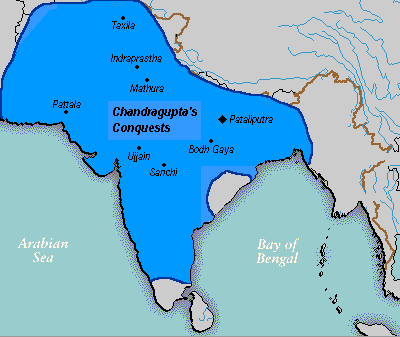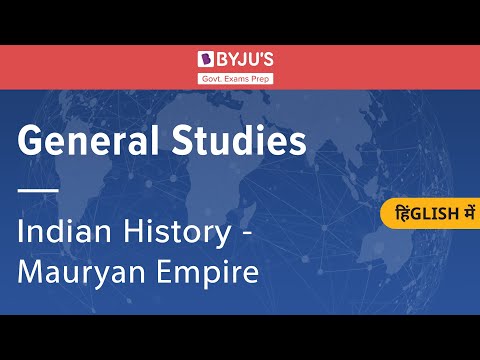In Ancient India, many significant empires evolved. One of them was the Mauryan empire. Founded by Chandragupta Maurya, the Mauryan empire was an important dynasty in our history. This article will provide NCERT notes on Mauryan Empire for the IAS Exam. These notes will also be useful for other competitive exams like banking PO, SSC, state civil services exams, and so on. This article talks about the rise and growth of the Maurya Empire in ancient India, which is an important topic in the history syllabus of the IAS exam.
Aspirants should also read other Ancient History articles related to Mauryan Empire linked in the table below:
| Mauryan Administration | Emperor Ashoka | Ashoka’s Edicts |
| The decline of the Mauryan Empire | Post-Mauryan India – Sunga Dynasty | Post-Mauryan India – The Satavahanas |
Mauryan Empire (UPSC Notes):- Download PDF Here
Mauryan Empire – Rise of the Mauryas
- The last of the Nanda rulers, Dhana Nanda was highly unpopular due to his oppressive tax regime.
- Also, post-Alexander’s invasion of North-Western India, that region faced a lot of unrest from foreign powers.
- Some of these regions came under the rule of the Seleucid Dynasty, founded by Seleucus Nicator I. He was one of the generals of Alexander the Great.
- Chandragupta, with the help of an intelligent and politically astute Brahmin, Kautilya usurped the throne by defeating Dhana Nanda in 321 BC.
Important Rulers of Mauryan Empire
The Mauryan Empire had rulers who were famous for their reign. The table below gives the list of Mauryan Empire rulers:
| Mauryan Empires – Rulers | |
| Chandragupta Maurya | (324/321- 297 B.C.) |
| Bindusara | (297 – 272 B.C.) |
| Asoka | (268 – 232 B.C.) |
Founder of Mauryan Empire – Chandragupta Maurya

- Chandragupta’s origins are shrouded in mystery. The Greek sources (which are the oldest) mention him to be of non-warrior lineage. The Hindu sources also say he was a student of Kautilya of humble birth (probably born to a Shudra woman). Most Buddhist sources say he was a Kshatriya.
- It is generally accepted that he was an orphaned boy born into a humble family who was trained by Kautilya.
- Greek accounts mention him as Sandrokottos.
- Alexander had abandoned his India conquest in 324 BC and within a year, Chandragupta had defeated some of the Greek-ruled cities in the north-western part of the country.
- Kautilya provided the strategy while Chandragupta executed it. They had raised a mercenary army of their own.
- Then, they moved eastward into Magadha.
- In a series of battles, he defeated Dhana Nanda and laid the foundations of the Maurya Empire in about 321 BC.
- In 305 BC, he entered into a treaty with Seleucus Nicator in which Chandragupta acquired Baluchistan, eastern Afghanistan and the region to the west of Indus. He also married Seleucus Nicator’s daughter. In return, Seleucus Nicator got 500 elephants. Seleucus Nicator avoided a full-scale war with the mighty Chandragupta and in return got war assets that would lead him to victory against his rivals in the Battle of Ipsus, fought in 301 BC
- Megasthenes was the Greek ambassador at Chandragupta’s court.
- Chandragupta led a policy of expansion and brought under one control almost the whole of present India barring a few places like Kalinga and the extreme South.
- His reign lasted from 321 BC to 297 BC.
- He abdicated the throne in favour of his son, Bindusara, and went to Karnataka with Jain monk Bhadrabahu. He had embraced Jainism and is said to have starved himself to death according to the Jain tradition at Shravanabelagola.
Second Ruler of the Mauryan Empire – Bindusara
- Son of Chandragupta.
- He ruled from 297 BC to 273 BC.
- Also called Amitraghata (Slayer of foes) or Amitrochates in Greek sources.
- Deimachus was a Greek ambassador at his court.
- He had appointed his son, Ashoka as the governor of Ujjain.
- Bindusara is believed to have extended the Mauryan Empire to Mysore as well.
Chanakya
- Teacher of Chandragupta Maurya, who was also his Chief Minister.
- He was a teacher and scholar at Taxila. Other names are Vishnugupta and Kautilya.
- He was also a minister in the court of Bindusara.
- He is credited to be the master strategist behind the usurping of the Nanda throne and the rise of the Mauryan Empire through his student, Chandragupta.
- He wrote Arthashastra which is a treatise on statecraft, economics, and military strategy.
- Arthashastra was rediscovered by R Shamasastry in 1905 after it had disappeared in the 12th century.
- The work contains 15 books and 180 chapters. The main theme is divided into:
- King, Council of Ministers and Departments of the Government
- Civil and criminal law
- Diplomacy of war
- It also contains information on trade and markets, a method to screen ministers, spies, duties of a king, ethics, social welfare, agriculture, mining, metallurgy, medicine, forests, etc.
- Chanakya is also called ‘Indian Machiavelli”.

Mauryan Empire (UPSC Notes):- Download PDF Here
Aspirants can check NCERT Ancient History Notes for UPSC page to get other important articles.
Related Links:
| UPSC Notes | NCERT Notes |
| UPSC Syllabus | UPSC 2024 |
| IAS Topper | Current Affairs |
| NCERT Medieval History Notes | NCERT Modern History Notes |
Relevant Links

Comments